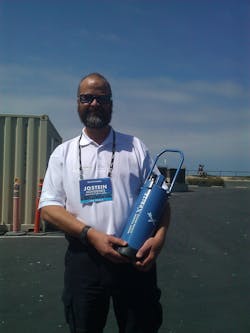Team Xylem is one of five teams that have just completed the final testing phase of the Wendy Schmidt Ocean Health XPRIZE, a global competition to create pH sensor technology that will accurately measure ocean acidification.
Made up of employees from Xylem brands Aanderaa and YSI, and from Xylem Analytics headquarters, Team Xylem began the Wendy Schmidt Ocean Health XPRIZE competition over a year ago with 18 other teams, all trying to develop affordable and accurate ocean pH sensor technology to monitor and measure ocean acidification—critical for determining ocean health.
Aanderaa and YSI collaborated on the project, leveraging their collective expertise in optical chemical sensors used in oceanography to create a pH-sensing platform. The Xylem entry integrates Aanderaa sensor technology and YSI calibration and validation systems, with a new solid-state opto-chemical sensor, or optode. It uses LED light sources and detectors tuned to the fluorescence of a pH indicator dye embedded in a sensing foil that interacts directly with the seawater. Any variation in ambient pH results in changes in the fluorescence of the indicator dye, which is then detected by the optics.
The Xylem solution is relatively small with low power requirements. It uses no reagents, consumables or moving parts, and offers very good stability. All of these features are critical for long unattended deployments on small platforms such as drifters, gliders, and autonomous underwater vehicles—which is the future of oceanographic monitoring.
Rising levels of atmospheric carbon are resulting in higher levels of ocean acidity, and even minute changes can have a profound effect on the health of ocean plant and animal life—like shellfish, fisheries and coral reefs—and ultimately impact the sustainability of our ocean ecosystems. The Wendy Schmidt Ocean Health XPRIZE was designed to incentivize the creation of breakthrough technologies to measure ocean acidification and provide critical data needed to better understand this threat to our oceans.
XPRIZE creates and manages high profile, large-scale competitions, incentivized with large prizes, to generate innovations that solve some of the world’s greatest technological challenges. The first XPRIZE competition was launched in 1996 as the Ansari XPRIZE for Suborbital Spaceflight, which encouraged teams to build private spaceships capable of carrying three people and flying two times within two weeks. Won in 2004 by astronaut Mike Melvill, this competition is credited with essentially launching the personal spaceflight industry.
Teams participating in the Wendy Schmidt Ocean Health XPRIZE competed for $2 million in prizes across two categories: an accuracy prize, based on technological performance, and an affordability prize, based on cost and usability. To get this far in the competition, teams had to successfully put their sensors through a three-month test under controlled laboratory conditions at the Monterey Bay Aquarium Research Institute in California this past fall, followed by a 30-day field-performance test, simulating a coastal environment sensor deployment, at the Seattle Aquarium in February. The final phase of the competition, which was completed May 21, was a week-long ocean challenge 100 kilometers off the coast of Oahu, Hawaii. The sensors were put through rigorous performance tests, while battling real-world pressure scenarios and depths of up to 3,000 meters below the surface.
“Getting to this point in the competition is really a validation of our expertise in sensor technology. It demonstrates the power within Xylem Analytics of cross-brand collaboration, and it exemplifies our expertise in the ocean space,” said Chris McIntire, Xylem SVP and president, analytics and treatment. “As an organization, we’re proud to have come this far in the competition. We went up against some world-class technology, and we were right there in the running. And that’s pretty exciting.”
Final decisions about the winning solution will be made once the data collected in Hawaii is analyzed and assessed, with the final winners being announced by XPRIZE in July 2015.
Source: Xylem

